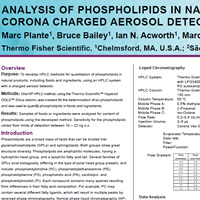
ANALYSIS OF PHOSPHOLIPIDS IN NATURAL SAMPLES BY NP-HPLC AND CORONA CHARGED AEROSOL DETECTION Marc Plante(1), Bruce Bailey(1), Ian N. Acworth(1), Marc Yves Chalom(2), Rodrigo de Sousa Leite(2) Thermo Fisher Scientific, 1-Chelmsford, MA, U.S.A., 2-São Paulo, SP, BR |
Resumo do Pôster:Charged Aerosol Detector, a sensitive mass-based detector, is ideally suited for the direct measurement of phospholipids, as they are non-volatile and non-chromophoric compounds. It offers excellent sensitivity (down to low nanogram amounts on column), a dynamic range of over 4 orders of magnitude, and similar inter-analyte response independent of chemical structure. A normal-phase HPLC method was developed for quantitation of phospholipids in natural products, including foods and ingredients, using an HPLC system with a charged aerosol detector. This developed method is based on an original publication by Rombaut, R., et al., (J. Dairy Sci., 2005, 88, 482), that enables the direct measurement of a number of glycerophospholipids and sphingolipids species, each as near-single peaks. The detector uses nebulization to create aerosol droplets. The mobile phase evaporates in the drying tube, leaving analyte particles, which become charged in the mixing chamber. The charge is then measured by a highly sensitive electrometer, providing reproducible, nanogramlevel sensitivity. This technology has greater sensitivity, dynamic range and precision than Evaporative Light Scattering and Refractive Index Detectors, is gradient compatible and is simpler to operate than a Mass Spectrometer (MS). Compounds do not have to possess a chromophore (unlike UV detection) or be ionized (as with MS). This sensitivity, combined with the linearity that is possible with use of the Corona Power Function, provides a unique and complete analytical solution for sensitive, reproducible, and routine analysis of non-chromophoric analytes. Sensitivities for the phospholipids were < 25 ng o.c. LOD. Linear calibration curves were found for all five phospholipid analytes, with correlation coefficients > 0.995 over four orders of magnitude. Phospholipids compositional results matched orthogonal results very well, and quantity amounts were similar, whereby differences were more likely due to sample preparation rather than chromatographic method conditions. |
